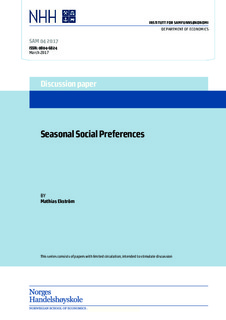| dc.contributor.author | Ekström, Mathias | |
| dc.date.accessioned | 2017-03-23T07:45:42Z | |
| dc.date.available | 2017-03-23T07:45:42Z | |
| dc.date.issued | 2017-03 | |
| dc.identifier.issn | 0804-6824 | |
| dc.identifier.uri | http://hdl.handle.net/11250/2435101 | |
| dc.description.abstract | Christmas is when people are expected to act selflessly for the well-being of others, but are people actually more altruistic at this time of the year? Responding to this question poses a challenge because of the confounding factors of charitable tax breaks, reciprocity motives, direct social pressure and persuasive campaigns for giving that are more prevalent in December. In this paper, I use a unique solicitation situation where these factors are eliminated. Using nine years of data and more than 50 million individual giving decisions, I provide three main results. First, the month of December is associated with an 18 percent increase in the proportion of donors, thereby providing strong support to the notion of seasonal social preferences. Second, exploiting a reform that changed the price of giving, I find that this December effect is equivalent to a 42 percent discount on charitable giving. Finally, half of the December increase in generosity persists into January before returning to the baseline in February. | nb_NO |
| dc.language.iso | eng | nb_NO |
| dc.publisher | Institutt for samfunnsøkonomi, NHH | nb_NO |
| dc.relation.ispartofseries | DP SAM;4/2017 | |
| dc.subject | Altruism; Charitable giving; Christmas; Social preferences | nb_NO |
| dc.title | Seasonal Social Preferences. | nb_NO |
| dc.type | Working paper | nb_NO |
| dc.subject.nsi | VDP::Samfunnsvitenskap: 200 | nb_NO |
| dc.source.pagenumber | 28 | nb_NO |
